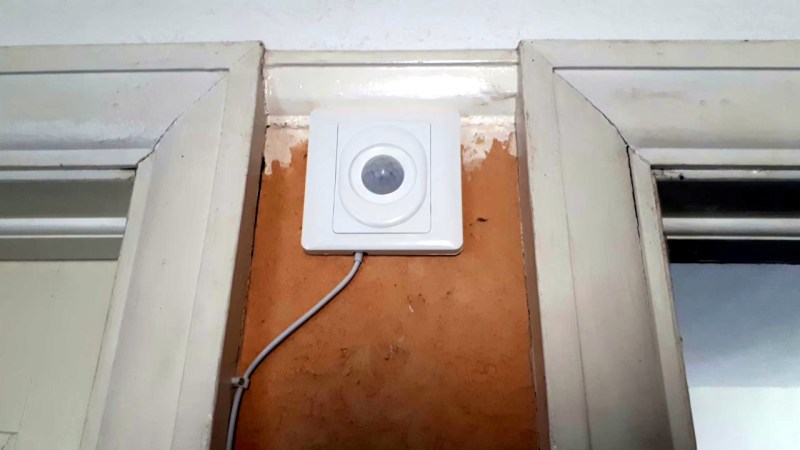It can be jarring to see various sensors, smart switches, cameras, and other technology in a house built in the 1930s, like [Chris]’s was. But he still wanted presence detection so as to not stub any toes in the dark. The result is a sensor that blends in with the home’s aesthetics a bit better than anything you’re likely to find at the Big Box electronics store.
For the presence detection sensors, [Chris] chose to go with 24 GHz mmwave radar modules that, unlike infrared sensors, can detect if a human is in an area even if they are incredibly still. Paired with the diminutive ESP32-S2 Mini, each pair takes up very little real estate on a wall.
 Although he doesn’t have a 3D printer to really pare down the size of the enclosure to the maximum, he found pre-made enclosures instead that are fairly inconspicuous on the wall. Another design goal here was to make sure that everything was powered so he wouldn’t have to perpetually change batteries, so a small wire leads from the prototype unit as well.
Although he doesn’t have a 3D printer to really pare down the size of the enclosure to the maximum, he found pre-made enclosures instead that are fairly inconspicuous on the wall. Another design goal here was to make sure that everything was powered so he wouldn’t have to perpetually change batteries, so a small wire leads from the prototype unit as well.
The radar module and ESP pair are set up with some code to get them running in Home Assistant, which [Chris] has provided on the project’s page. With everything up and running he has a module that can control lights without completely changing the aesthetic or behavior of his home. If you’re still using other presence sensors and are new to millimeter wave radar, take a look at this project for a good guide on getting started with this fairly new technology.















It looks like he mounted one of those little spider eye diffusers over the mmwave module. Does that affect the reception at all? I’ve been setting up some of these recently and the detection range is very finicky.
Works perfectly up to 3.5m, which is all it needs to.
The plastic element used in front of the sensor is a focus element that is needed for passive infrared detectors. It concentrates the infrared radiation in a non uniform way onto the detector.
The comment was suggesting that it is useless for a microwave sensor and may even disturb the sensing. Fine if it still works.
The article suggests a goal “to blend in with the aesthetics” where microwave sensors could be placed much more discretely. A flat discrete box or even a stucco style decoration could be created. But looks like this was not the intention of the author
Why would it be jarring unless there’s no microwave oven and the entertainment center is a tube radio
Fairly inconspicuous?
Let me ask the missus about the WAF of this.
.
.
.
Yep, just as I expected. This would never be allowed in our house.
Yeah that looks like it was just picked up at a Home Depot. Inconspicuous or “fits into 1930s style” aren’t the words I’d use.
The style wasn’t really the aim. I mentioned that it was a 1930s house because all the internal walls are brick rather than studwork, which has become more of a thing in new builds here. It makes running hidden wiring a mission that requires chasing out and replastering.
I kinda figured “blends with the home’s aesthetics” was the blog author’s addition, and not something you were aiming for. No shame in using what’s available.
Now, if you really wanted something that would fit in, you could get an antique wall intercom like this https://www.ebay.com/itm/205402676047 and hide the sensor in the microphone horn.
It’d have to be much lower on the wall, of course.
A mmWave sensor could just be hidden behind a socket blanking plate
Good hack, but this is a tough crowd.
How about one of these?
https://www.ikea.com/gb/en/p/vallhorn-wireless-motion-sensor-smart-white-90504341/
Tasteful, discreet, no wires, inexpensive, easy to integrate.
Did you get the bit about not wanting batteries?
Sure. If you’re building your own stuff then power management is tedious, so, no batteries. But, the IKEA sensor lasts for a while on fresh batteries, and you can also use rechargeables.
Having said that, I do have an ESP8266 in a corridor monitoring temperature. It’s powered from a USB PSU plugged into a nearby outlet, but I tacked the cable to the door frame to make it as unobtrusive as possible. It’s also in a tidier enclosure.
Based on the photo I’d drill a hole through the cornice and push the wire up and along to somewhere else.
If the solutions were otherwise the same I’d go for that, assuming the batteries lasted a good long while between charges.
However there’s a massive quality of life difference between mmWave and PIR presence detection. PIR is fine for a hallway or entrance area where you don’t need to hang around but for a room you want to use for an extended period of time PIR is rubbish even with a long cooldown time. Ask any office worker whose company has installed motion activated meeting room lights.
“Ask any office worker whose company has installed motion activated meeting room lights.”
Or bathroom lights.
Unless you want a virtual darkroom a tiny low voltage LED light in the right place can be left on and still save energy compared to all the tech to control lighting. I took a early LED flashlight with one classic emitter and aimed it at the throne, no blinding light to turn on. It’s hooked up to a switching wall wart and slim wiring to above the target which is easy to see.
Does it work on wandering spirits?
As far as anyone will ever be able to prove, yes.